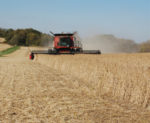Advertise Follow Us
Cover Crops
Take a Step-By-Step Approach When Converting To No-Till
Cereal rye, vertical tillage and a deliberate, field approach helped Ohio no-tillers Jim and Susie Braddock convert their 2,400-acre farm to no-till
Read More
Ohio Field Day Yields Tips To Enhance No-Till
No-tillers can use liquid manure and cover crops to improve their soil structure and yields if they follow some simple guidelines, experts say.
Read More
Could Energy Crops Be In Your Rotation’s Future?
Switchgrass, miscanthus, camelina and other crops could provide new markets and opportunities for enterprising no-tillers.
Read More
New, Recycled Cover Crops Showing Plenty of Potential
Add more diversity and numerous soil-building benefits to no-till with these up-and-coming options.
Read More
No-Till Tradition, Passion For Change Fuel Miller Farms
Wisconsin no-tillers make use of cover crops, gypsum, winter wheat and precision ag to enhance soil biology and bump up no-till yields.
Read More










